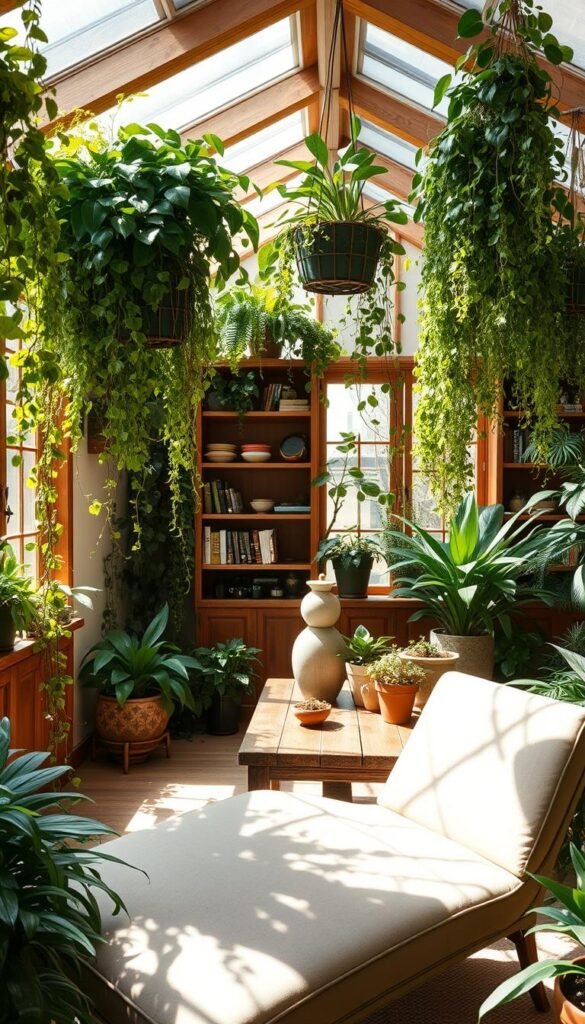Imagine stepping into a vibrant oasis where fresh air meets calming greenery. Turning part of your home into a thriving indoor garden does more than beautify your space—it actively boosts your well-being. Studies show plants filter toxins, increase oxygen levels, and create natural stress relief zones. This isn’t just decor—it’s a lifestyle upgrade.
Why are so many Americans embracing this trend? Beyond cleaner air, greenery taps into our biological need to connect with nature. Your leafy companions help lower anxiety, sharpen focus, and even spark creativity. They transform blank corners into living art while working silently as air purifiers.
You don’t need a green thumb to start. Even small arrangements can make your home feel rejuvenating. Whether it’s a sunny windowsill or a cozy reading nook, plants adapt to your space. Ready to discover how a few pots can reshape your environment—and your mood?
Setting Up Your Indoor Garden Oasis
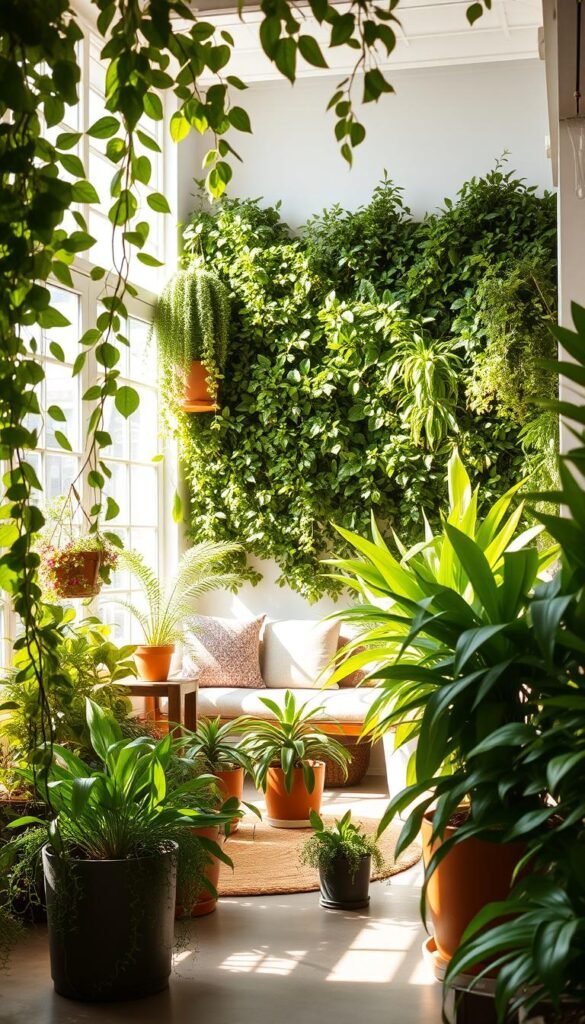
Your leafy retreat starts with picking the right room for growth. Whether it’s a bright kitchen nook or an underused hallway, every space holds potential. Focus on areas that blend daily life with plant care—think cozy corners near windows or spots where you naturally unwind.
Find Your Green Zone
Start by mapping sunlight patterns. South-facing windows offer intense light for succulents, while east-facing ones provide gentle morning rays for ferns. Use a light meter app or track shadows hourly to identify zones with consistent natural light. For tight quarters, vertical shelves or hanging planters maximize floor space without clutter.
Balance Comfort and Care
Every environment has quirks. Bathrooms work wonders for humidity-loving plants like orchids, while living rooms suit air-purifying snake plants. Watch for drafts near doors or heat vents that cause temperature swings. Pro tip: Group plants with similar needs to simplify watering and create mini microclimates.
Key factors to evaluate:
- Daily light duration (4+ hours for most greens)
- Airflow from fans or open windows
- Proximity to water sources for easy care
Choosing the Perfect Plants and Containers
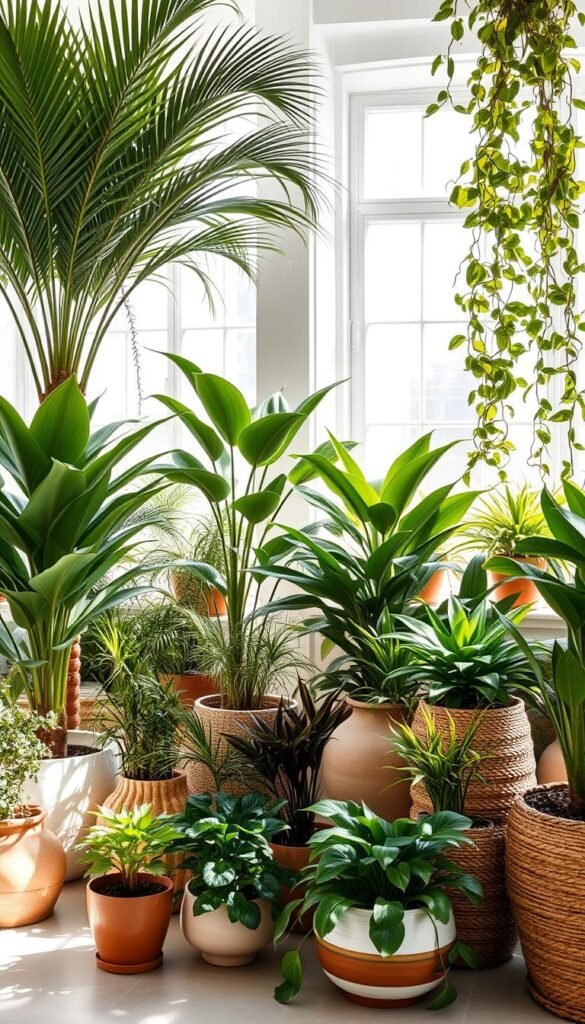
The secret to a thriving green space lies in pairing the right plants with their perfect pots. Start by evaluating your daily routine—how much time can you dedicate to care? This simple question separates low-effort greens from high-reward showstoppers.
Selecting Low-Maintenance vs. High-Care Plants
Beginner-friendly houseplants like ZZ plants and snake plants survive weekly neglect while purifying air. Spider plants bounce back from missed waterings, making them ideal for busy schedules. For those craving drama, orchids and maidenhair ferns demand precise humidity but reward you with breathtaking blooms.
| Plant Type | Care Level | Light Needs | Best For |
|---|---|---|---|
| Succulents | Easy | Bright direct | Sunny windows |
| Peace Lily | Moderate | Low indirect | Bathrooms |
| Fiddle Leaf Fig | Advanced | Filtered bright | Room centers |
Matching Containers and Materials with Your Style
Your pots should complement both your plants and decor. Terracotta breathes well for moisture-sensitive succulents, while ceramic glazed planters retain water for tropical varieties. Consider self-watering options if you travel often—they’re lifesavers for thirsty houseplants.
Scale matters too. A 10″ fiddle leaf fig needs a heavyweight base, while trailing pothos shines in hanging baskets. Mix materials like woven seagrass or concrete for visual texture that grows with your collection.
Lighting, Humidity, and Other Essentials
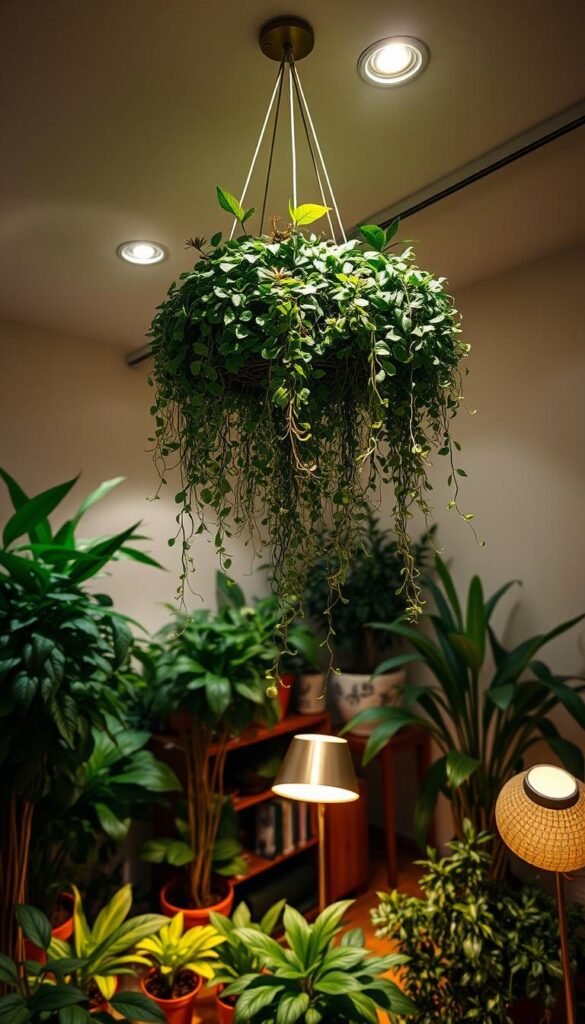
Brightness defines your plant space’s success. Without proper light, even hardy greens struggle. But don’t worry—whether your windows flood with sun or you rely on bulbs, solutions exist.
Optimizing Artificial and Natural Light
Track how sunlight moves through your space. Morning rays suit ferns, while afternoon beams fuel succulents. Use a light meter app or note shadow patterns weekly. No south-facing windows? Full-spectrum LEDs save the day.
| Light Type | Best For | Daily Duration | Key Benefit |
|---|---|---|---|
| Full-Spectrum LED | Low-light areas | 8-12 hours | Mimics natural sunlight |
| Fluorescent | Seedlings | 10-14 hours | Energy-efficient |
| Pendant | Accent lighting | 4-6 hours | Enhances room ambiance |
Place lights 12 inches above plants for even coverage. Rotate pots weekly to prevent lopsided growth. Pair with colorful container gardens to amplify visual impact.
Humidity matters too. Group moisture-loving plants like orchids near trays of wet pebbles. Misters work for quick sprays, but humidifiers maintain steady levels. Keep your environment balanced—40-60% humidity keeps leaves perky.
Evening lighting transforms your green corner into a relaxing retreat. Try warm-toned floor lamps to highlight trailing vines. Your plants thrive, and your room glows.
Creating an Indoor Garden Room: Transforming Any Space into a Plant Haven
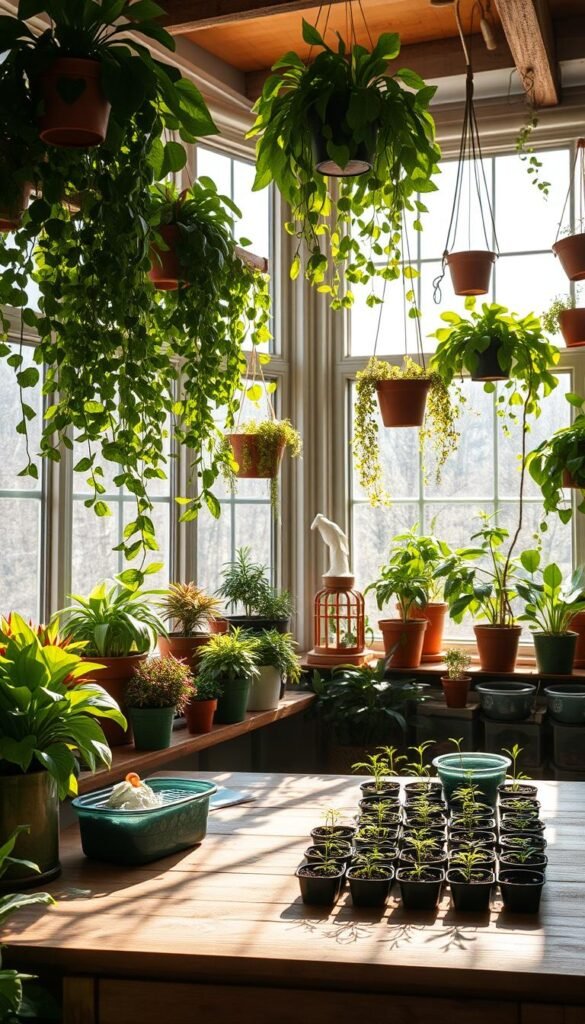
Ready to turn that empty corner into a lush retreat? Follow this structured approach to build your green paradise without missing a beat. We’ll help you avoid common pitfalls while maximizing your room’s potential.
Step-by-Step Setup Process
Begin by sketching your layout. Use painter’s tape to mark where plants will go, considering their mature sizes. Start with three easy-care varieties like snake plants or pothos—they’re forgiving while you learn.
Elevate your display with staggered shelves. Tall fiddle leaf figs anchor floor spaces, while trailing ivy softens bookshelves. For vertical impact, try wall-mounted planters that double as living art. Keep watering cans and tools within reach using decorative baskets.
Integrating Expert Tips into Your Garden Design
Mix leaf textures for visual drama—pair spiky succulents with velvety philodendrons. Rotate seasonal bloomers like orchids to maintain year-round interest. “Always leave breathing room between pots,” advises NYC plant stylist Mara Trivino. “Overcrowding stresses plants and limits growth.”
During setup day, position humidity trays first. Place light-hungry greens near windows, then build around them. Test sightlines from seating areas to ensure your arrangement delights from every angle. Adjust placements weekly as new growth appears.
Styling Tips for a Successful Indoor Garden Room
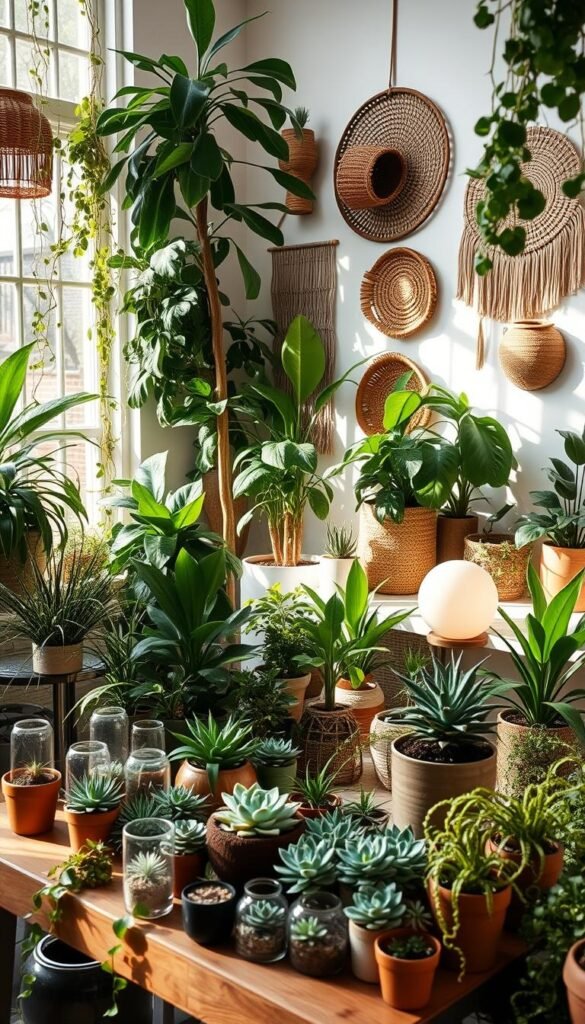
Transform your plant collection into a living masterpiece through smart design choices. The right elements turn functional greenery into eye-catching decor that complements your home’s personality.
Mixing Form and Function
Elevate small spaces with tiered plant stands. These multi-level containers create depth while saving floor area. Try pairing a 24″ metal stand with trailing pothos and compact succulents for layered appeal.
Wall-mounted shelves unlock vertical potential. Install floating wood planks near windows for cascading spider plants or herbs. For bold statements, try living frames filled with air plants—they thrive without soil.
| Decorative Element | Best Use | Style Impact |
|---|---|---|
| Tiered Stands | Small spaces | Adds height variation |
| Floating Shelves | Vertical displays | Modern aesthetic |
| Glass Terrariums | Tabletop accents | Minimalist appeal |
Mix leaf textures for visual drama. Combine rubbery ZZ plant leaves with feathery ferns. Add pops of color through flowering varieties like purple oxalis or red anthurium.
Incorporate functional furniture like ottomans with hidden storage for tools. Position a rattan chair beside your tallest plants to create a cozy reading nook. Mirrors behind greenery amplify light and make spaces feel larger.
Rotate seasonal elements to keep displays fresh. Swap autumn-hued crotons for spring-blooming orchids. This living art evolves with your style while maintaining year-round interest.
Final Touches to Complete Your Indoor Garden Sanctuary
Your green retreat becomes truly self-sustaining with smart maintenance habits. Create a weekly checklist that aligns with your schedule—check soil moisture every Monday, wipe leaves every Thursday. Use phone reminders or colorful sticky notes near your plants until routines feel natural.
Prevent pests before they strike. Inspect leaf undersides during watering and keep neem oil spray handy. For indoor garden inspiration, mix decorative pebbles into topsoil—they improve drainage while adding texture. Rotate pots monthly to ensure even growth.
Track progress in a dedicated journal. Note new leaves, bloom cycles, and fertilizer dates. Share cuttings with friends using recycled jars—it spreads joy while managing your garden’s size. Over time, you’ll spot patterns that help refine care.
Your living space now doubles as a wellness hub. Morning coffee tastes better surrounded by thriving greens, and evening wind-downs gain calmness. This oasis doesn’t just purify air—it nurtures your daily rhythm through nature’s quiet magic.

